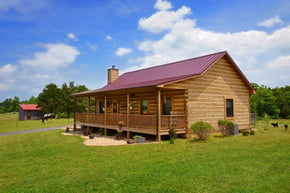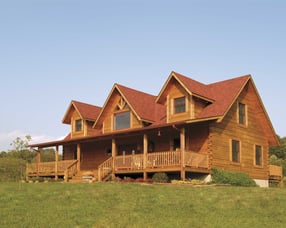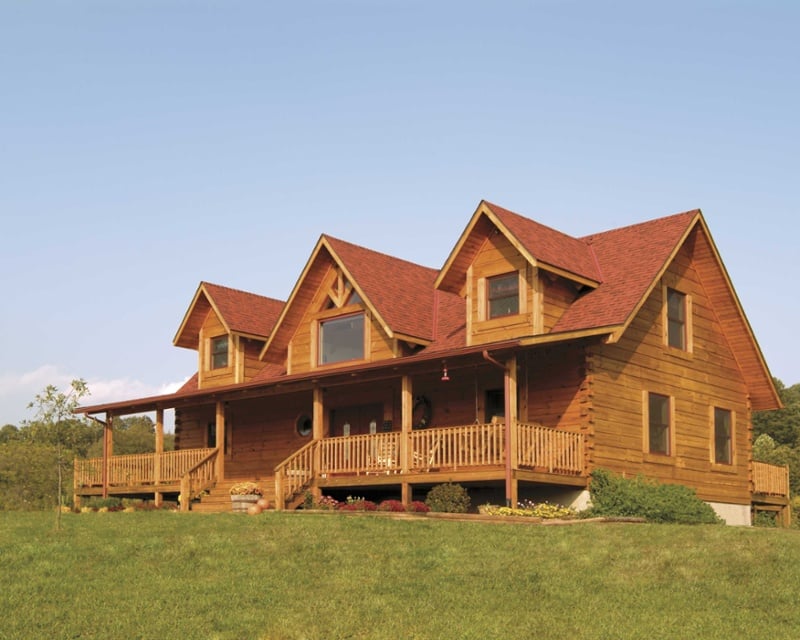Ran across an interesting article (see below) in www.builderonline.com that may interest many of you when researching roofing solutions for your new log home, or if you are considering re-roofing your existing home. In the 24 years of selling log homes, this is one of the most frequently asked questions we're asked to give an opinion on. It really comes down to budget, but the insight offered below is valuable when making a decision.


If you were to ask a sampling of production builders what is the best roofing material on the market, they’re likely to tell you asphalt. The average residential architect, on the other hand, would probably say metal is the real deal. Heaven only knows what a home buyer or custom home client will choose—slate, clay, concrete—or if they’ll even care.
The roof is arguably the most important surface in a home, perhaps even more essential than the exterior walls. As the most exposed plane, the roof has a mammoth task. It’s under constant assault from the sun and rain, and, if leaky, could result in thousands of dollars worth of direct repair as well as ancillary damage. Still, a roof is one of those things that many consumers don’t think about until there is a blizzard, hail storm, or rainstorm.
So what accounts for the discrepancy in material tastes? That builders, architects, and home buyers have opposing views of roofing material is telling, but their preferences speak to individual agendas as much as it speaks to the materials.
Most home buyers, for example, care mostly about price and don’t care as much about material as long as the roof functions properly and for the foreseeable future. Production builders care about looks and function, too, but affordability is top of mind. And architects want a roof to function well, but they are concerned that it be aesthetically pleasing.
Naturally, the asphalt industry says its product is the best roofing you can buy. “Asphalt roofing is easy to find, easy to install, and easy to maintain,” the Washington, D.C.-based Asphalt Roofing Manufacturers Association says. “It's also incredibly easy on the eye. And let's not forget, it's easy on the wallet, too!”
Indeed, asphalt is easy to install and produces a decent-looking roof, but most architects and builders say the product is popular mainly because it’s economical.
Depending on the product line, shingles come with warranties lasting anywhere from 20 to 30 years, though builders in the field say the numbers are often shorter depending on the location of the country and maintenance.
The asphalt roofing industry makes a good case for its product being No. 1 because its product is No. 1. Industry estimates claim four out of five roofs are covered with asphalt, though if you drive around most subdivisions—new or established—that number seems woefully low.
Asphalt’s market share notwithstanding, the metal people say their product is much better. According to the Metal Roofing Alliance in Belfair, Wash., “Longevity is one of the top reasons consumers report choosing metal roofing for their homes.” The group says “metal roofing can last as long as 50 years or more, requiring very little maintenance and looking beautiful all the while.”
When HUD’s Partnership for Advancing Technology in Housing launched the Concept Home program some years ago, the group’s mission was to use the best available materials, products, and technology for the homes it builds. The group settled on metal roofing for its subsequent homes in Omaha, Neb., and Charleston, S.C., because of the looks and the longevity—benefits that architects often cite as their reason for choosing the material. They are mesmerized by the crisp, contemporary look; that it lasts forever is gravy.
But longevity and good looks come with a very high price, one that turns off even ardent admirers of metal. “I use asphalt on all my projects,” says Texas-based builder Robert Aiken. “Metal is a better roof, but it costs three times as much.”
So where does that leave you? The tradeoffs are not so simple. Both materials are versatile, offering a variety of looks. But is it enough to specify an asphalt roof that should last 20 years or more? Or is it worth it to pay three times as much for metal that could outlive the homeowner and the house? Considering how long the average home buyer stays in a house, the answer may be simple.
Here's a handy guide that outlines the pros and cons of asphalt versus metal roofing. Use it to evaluate the options for your customers, and let us know what you use and why.
Pros for Asphalt Shingles:
An accepted and proven material that builders know and trust. There’s a reason so many builders use the product, and it comes down to 100 years of service in the home building industry. Plus, home buyers are comfortable with it, which is extremely important.
Economical. The low cost of asphalt is probably its biggest selling point. A basic three-tab shingle roof might set you back about $100 to $200 per square (or a 10-foot-by-10-foot area), making it ideally suited to production housing or to entry-level housing.
Easy to work with and handle. Perhaps no other roofing product is as easy to install. In some cases, a house can be done in one day by professional contractors. Even serious DIYers have been known to tackle roofing projects, though it’s highly recommended that they don’t because of warranty issues.
Easy to repair. As easy as asphalt is to install, it’s equally easy to repair if it gets damaged.
Style options. Asphalt comes in basic offerings for the cost-conscious, but it can be ordered in fancy styles that mimic wood shakes or slate. Basic three-tab shingles dominate the category, but thicker, high-end laminates are available in many colors and with deep shadow lines.
Good performance record. Depending on the product line, asphalt shingles come with a 20- to 30-year warranty. Many are fire-rated (as high as Class A), and require minimal maintenance. Some manufacturers offer products that meet Energy Star requirements and qualify as a cool roof under federal standards, making them eligible for tax credits.
Cons for Asphalt Shingles:
Can be boring. Though snappy colors and styles are available, builders tend to select basic single-color products that have a tendency to look dull.
Susceptible to severe weather. In general, asphalt provides good uplift protection, but the product does not hold up well to severe weather such as hail. The NAHB Research Center sayswind- and impact-resistant shingles are available, but they cost about 50 percent more than conventional products. Moreover, asphalt roofs that do not get adequate sunlight can be vulnerable to moss, mildew, and algae, which can shorten lifespan.
Longevity questions. Warranties on asphalt roofs are relatively high, but performance is closely tied to a well-ventilated roof deck and homeowner maintenance.
Can be heavy. While basic shingles weigh about 200 pounds per square, some laminated, textured, and higher-end architectural shingles can clock in at close to 500 pounds per square.
Nascent recycling. According to the Northeast Recycling Council, the U.S. manufactures and disposes of about 11 million tons of asphalt shingles per year. Most—about 10 million tons—is from installation scraps and tear-offs from re-roofing. Moreover, the group cites EPA studies that shingle waste makes up 8% of the total building-related waste stream. The asphalt recycling industry is still young, however, though manufacturers are developing ways to find uses for the material including pavement, new roofing, and road and ground cover, says the California Department of Resources Recycling and Recovery.
Pros for Metal Roofing:
Lightweight. Metal is about the lightest material you can install on your roof. Though weight varies based on type, contractors and manufacturers say aluminum varies from about 50 pounds per square, while steel can be anywhere from 100 pounds to 250 pounds per square, says MetalRoofingSource.com.
Longevity. Metal offers good weather resistance and can last a long time. There are rumors of copper and zinc metal roofs in Europe lasting well over 100 years. Though this might be possible with care and maintenance, you can reasonably expect a metal roof to last about 60 years, give or take.
Long warranty. Many metal manufacturers offer limited warranties that last up to 50 years.
Stellar extreme-weather performance. Contractors say metal is excellent at preventing leaks, offers good wind resistance, and is fireproof. In fact, says the Metal Roofing Alliance, some insurance companies offer home buyers up to 30% reduction in premiums for weather-resistant metal roofs .
Environmentally friendly. One of the most energy-efficient roofing materials, metal reflects heat and helps keep houses cooler in the summer. Plus, the product often contains high, recycled content and is itself recyclable.
Cons for Metal Roofing:
Very expensive. Metal’s biggest drawback is the cost. Though manufacturers say prices have come down, metal, on average, costs three times as much as asphalt. Pricier metals such as stainless steel, copper, and zinc can cost way more.
Can have a harsh appearance. Metal has a long history on barns and agricultural buildings, but for those who aren’t familiar with this look, it can be harsh in a residential subdivision.
Extreme expansion and contraction. Critics contend that some metal roofs expand and contract quite a bit, which compromises their long-term performance and their ability to remain water tight. This is often a function of the installation.
Past failures and perception issues. Architects say there was a time when basic corrugated metal roofs corroded in 10 years or less. In some seaside applications, rust on some roofs is visible. Most products today, however, are made with alloys and specialized resin paints that can handle salt spray, extreme heat, and heavy precipitation without issue, the industry says.
Product selection is important for good performance. Though high-performing materials such as stainless steel, copper, and zinc are available, low-end steel products are still available. Architects advise against low-grade metals that are thinner and less durable, especially near seaside locations.
Nigel F. Maynard is a senior editor for Builder magazine.



.png?width=137&height=70&name=blue-seal-120-61-bbb-21001218%20(1).png)